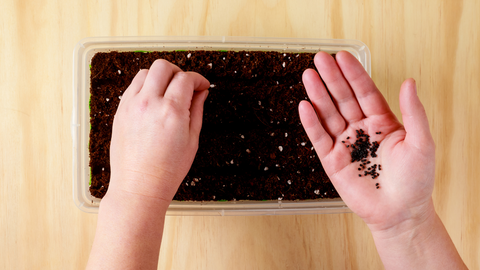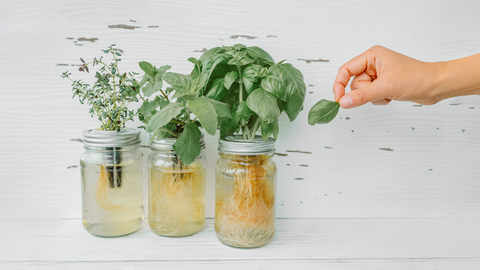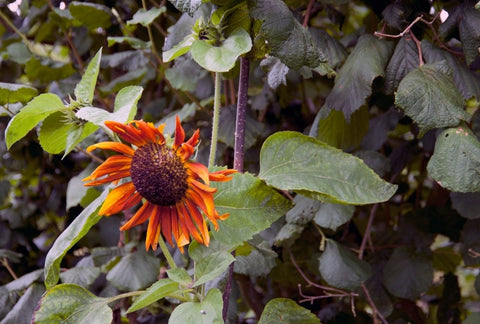Growing herbs from seed is a fun and rewarding project. The satisfaction of being able to say “I grew that” as you serve them up for dinner is hard to match! Not to mention, growing your own food is good for both your health and the planet.
Like most things, a little background knowledge and research on the basics is going to drastically increase your chances of success. Thankfully, you’re in the right place to do just that!
5 Essential Tips For Growing Herbs From Seed
We recommend taking a moment to think about what you are going to do with your herbs as they sprout and grow larger, as this will influence the type of equipment you need. The main decision you want to make ahead of time is whether you are going to be growing your herbs INDOORS or OUT.
- Look at some historical climate data for your area.
- Figure out when the last spring frost typically occurs (you can also just google “when is the last spring frost for [your area]”).
- Deduct 6-8 weeks from this date.
- Aim to plant your herb seeds around this time.
- Make sure that the growing medium you use for herb seed starting is large enough to allow the roots to develop somewhat over this period (we’d suggest at least a 2-3” pot).
Essential Supplies to Grow Herbs From Seeds
Once you've figured out when and where to start your herb garden, the next step is to sort out your supplies. Yes, these materials are available at your local big-box hardware store, but the problem with shopping there is you'll only have access to cheap mass-market seeds containing generic seed cultivars (typically the cheapest ones the supplier was able to source).
Gardening in an urban setting brings a number of unique challenges, including (typically) less space, less light, greater risks of pests and disease, and (depending on the diligence of the gardener (!) - sometimes even less reliable watering schedules). We therefore recommend seed cultivars and supplies that are catered to your environment. Essential supplies include:
- Some high quality seeds. Given our 'urban' focus, the seed cultivars we offer will typically be more compact, have denser foliage, and where possible have better pest and disease resistance than the cheap generic ones you find at the hardware store or most nurseries.
- Seed Starting Mix. Our favorite brand for this is Rosy Soil, because it's peat-free and also includes worm castings.
- Coco Coir Pots. These are great for transferring into the ground, and are 100% backyard compostable.
If you are growing herbs INDOORS then the ultimate goal is likely to grow your herbs in pots. Some herbs such as dill, parsley and cilantro don’t particularly enjoy being transplanted, so if there’s an option to place these seeds directly into their final home that’s what we’d recommend. A great way to achieve this is with a self-watering ceramic planter, like the below. The porous ceramic walls of this planter will slowly let water into the soil, keeping your herbs perfectly hydrated at all times.
Are Herbs Hard to Grow?
Herbs are one of the easier edible plants to grow at home and are generally suitable for beginner gardeners. Some of the easiest are chives, basil, cilantro, and parsley.

Another thing to keep in mind when selecting your herbs is that within most common herb varieties (e.g., "Thai Basil") there are dozens of different cultivars or 'strains'. Some are short and compact, others are tall. Some have been bred for pest, disease, and low light tolerance, others are not. When you shop for seeds at a 'big box' store you're likely to get the cheapest and most generic cultivars the seed packager was able to get their hands on. One of the things we pride ourselves on here at Urban Leaf is our careful curation of cultivars that are specifically selected for indoor and urban growers. More on that in this blog, if you're interested.
How to Start Growing Herbs Indoors?
If you are starting to grow your herb garden seeds indoors, then you might want to consider some sort of germination tray.
These can be helpful to
- Serve as a tray for water (as it helps to keep your growing medium in a little bit of water so they are always hydrated) and
- The lid can help trap humidity
- Dill: from sprout to harvest, you can expect them at about 40 days
- Cilantro: You can harvest your own cilantro leaves after 50-60 days
- Basil: Same with cilantro, after 50-60 days, you can pick your own fresh basil leaves
- Herbs that like light to germinate include: Thyme and Lemon Balm
- Most of the other herbs we offer including Basil, Chives, Cilantro, Cosmos, Dill, Marigold, Mint, Oregano, Parsley and Zinnia prefer a slightly darker germination environment.
- Water. The soil or growing medium you use should be damp, but not soggy...
- Nutrients. Seed starting mixes like coco coir and peat moss generally do not contain much in terms of nutrients...
- Light. You eat food, plants eat light. If they fail to get enough of it, they will starve...
Although these are available as ready-made kits, our personal preference is to avoid the extra plastic and just reuse something you already have - this blog covers a few such ideas.
You can also check out our How to Grow Indoor blogs for more ideas.
When is the Best Time to Plant Herbs Indoors?
You can plant your herbs indoors all throughout the year, but we recommend that you start growing these herbs during early spring or March. This will mean that as the herbs mature they are doing so in Spring/Summer when days are longer and there’s more natural light. One of the benefits of growing herbs indoors of course is that you can do it any time of year. Just be mindful that if you don’t have at least 4-6 hours a day of natural light then you will need to supplement it with a grow light.
What are Some of the Fastest Growing Herbs from Seed?
If you are interested in starting your own herb garden but have little time to spare for planting and caring, here are some of our recommended fastest growing herbs for you to plant.
Which Herb Seeds Need Soaking?
One day before you plan to get set up, it’s a good idea to soak some herb seeds. Although it's not essential, soaking herb seeds helps soften the hard outer shell of some varieties thereby increasing their germination rates. Varieties that benefit from pre-soaking for 12-24hrs include parsley and coriander.

What Is The Right Herb Growing Temperature?
Herbs are living things, and just like us that means they are sensitive to temperature extremes. Either too hot or too cold and you’ll have a problem.
If you are seed-starting indoors in anticipation of spring, then probably the biggest threat is cold windows / window sills. The sun from a window will be important once they sprout, but when you’re at the germination stage it is far less important. More important in the first few days is temperature. These little herb seeds are smart enough to know that if it’s cold out then it must still be winter, and there’s no point in them sprouting.
You need to trick the seeds into believing that they are coming into spring and that the temperatures are therefore warmer. 65 - 75F is a good range to aim for, and if your home doesn’t allow for this then consider getting a heat mat to place under the seeds while they are getting started.
Which Herb Seeds Need Light To Germinate?
Some herb garden seeds need a little light in order to encourage germination, which means they should be placed on or near the surface. Others prefer darkness, so we recommend placing a thin layer of soil over them - a good rule of thumb is that the soil layer should be no deeper than the length of the seed.
How Far Apart to Plant your Herb Seeds?
Of course, every herb seed has a different way of how it can be planted. One herb garden seed example is oregano, which takes at least 7-14 days to germinate. We recommend that you plant its seeds at least 18-22 inches apart.
For more information on how far apart to plant your herb seeds, you can check out our other blogs about How to Grow Herbs Indoors. In these blogs, we specified how far you should plant your herb seeds for all the different types of herbs.
Labeling Your Herb Garden Seeds
This might sound obvious, but you’d be surprised how many people skip it! Once you’ve become familiar with them, it’s easy to tell the difference between fully grown herb plants, but when they’re little seedlings they are much harder to differentiate! Be sure to use some sort of sticker or label to mark which is which. Trust us, you’ll be glad you did.
Transplanting Herbs
Planting herbs inside your home is easy, but if you want to transplant your herbs outdoors, you can do that, too. To know more about transplanting some of the most common herbs, check out this article.
What To Expect Next
Once your seeds have sprouted, which can take anywhere from 2 - 15 days, the hard part is over. From here, maintaining happy and healthy herbs is essentially about managing three essential inputs:
Hopefully, this article has given you the foundational knowledge you need to give this rewarding hobby a go. There’s so much to gain from gardening and growing your own food, and really very little to lose. If you’re interested in giving it a shot, then remember Urban Leaf is the ONLY company that offers an unlimited returns and refund policy. If things don’t work out, we will refund or replace your purchase at any time, and for any reason.
If you have additional questions then feel free to either leave a comment below or shoot us an email at help@geturbanleaf.com.












There are no comments for this article. Be the first one to leave a message!